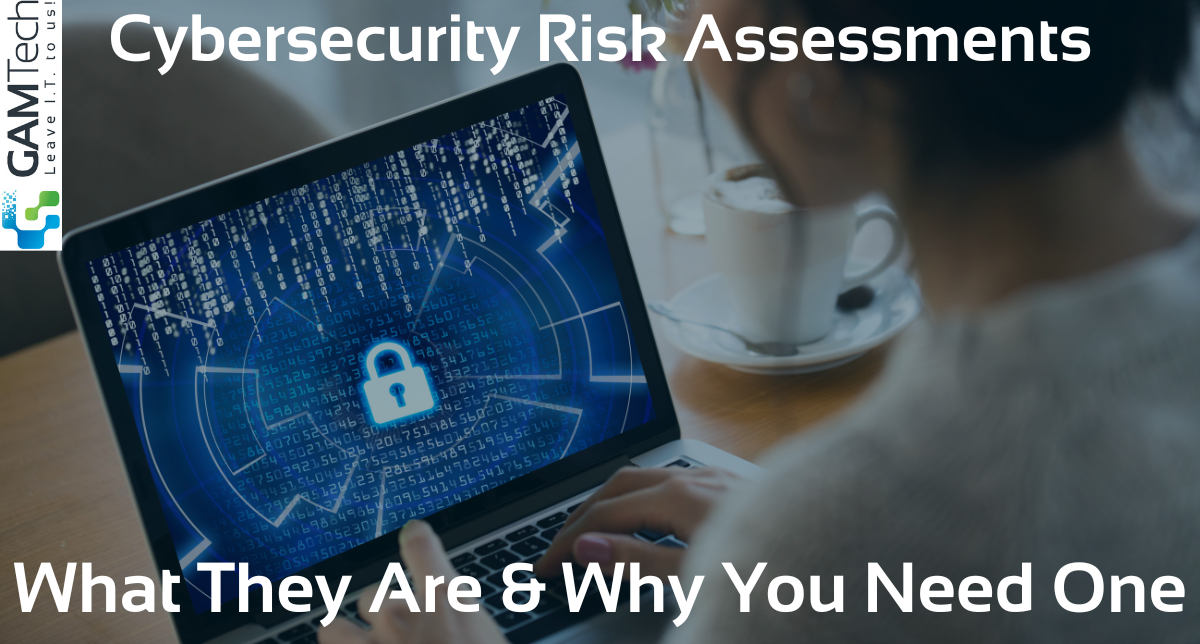Small Business Data Breach: Complete Protection and Response Guide
Small businesses face a stark reality in today's digital landscape: 46% of all data breaches target companies with fewer than 1,000 employees, yet...
7 min read
 Adrian Ghira
:
Jun 23, 2024 8:30:06 AM
Adrian Ghira
:
Jun 23, 2024 8:30:06 AM

A cybersecurity risk assessment is a systematic evaluation process that identifies, analyzes, and prioritizes potential security threats and vulnerabilities within your organization's IT infrastructure to develop targeted mitigation strategies and strengthen your overall security posture.
With cyberattacks becoming increasingly sophisticated and costly, conducting regular cybersecurity risk assessments has evolved from a best practice to a business necessity. Whether handled through internal resources or professional cybersecurity services, these assessments provide the foundation for making informed security decisions.
This comprehensive guide will walk you through everything you need to know about cybersecurity risk assessments, from understanding their importance to implementing an effective assessment strategy for your organization.
A cybersecurity risk assessment is a structured methodology that helps organizations understand their security landscape by systematically examining three critical components: assets, threats, and vulnerabilities. This process goes beyond simple security audits by providing a quantitative and qualitative analysis of potential risks and their business impact.
The assessment serves as a foundation for informed decision-making about cybersecurity investments and resource allocation. Rather than implementing security measures randomly, organizations can prioritize their efforts based on actual risk levels and potential business impact.
Key Components of a Risk Assessment:
The digital transformation of business operations has created unprecedented opportunities for cybercriminals. Organizations that fail to conduct regular risk assessments operate blindly, leaving themselves vulnerable to attacks that could have been prevented or mitigated.
Regular assessments provide comprehensive visibility into your security landscape, enabling you to identify and address vulnerabilities before they can be exploited. This proactive approach significantly reduces the likelihood of successful attacks and helps maintain robust defenses against evolving threats.
Understanding your risk profile allows for strategic allocation of cybersecurity resources. Instead of spreading investments thinly across all areas, you can focus on the most critical vulnerabilities and highest-impact threats, maximizing the effectiveness of your security budget.
Many industries require regular risk assessments as part of compliance frameworks such as GDPR, HIPAA, or PCI DSS. Conducting thorough assessments demonstrates due diligence and can provide legal protection in the event of a security incident.
By identifying potential disruptions and developing mitigation strategies, risk assessments help ensure business operations can continue even when facing security challenges. This resilience is crucial for maintaining customer trust and competitive advantage.
Preventing security incidents is significantly more cost-effective than responding to breaches. Risk assessments help organizations avoid the substantial costs associated with data breaches, including incident response, legal fees, regulatory fines, and reputational damage.
Conducting an effective cybersecurity risk assessment requires a systematic approach that ensures all critical areas are evaluated consistently. Here's a detailed step-by-step process:
Begin by clearly defining what will be included in your assessment. The scope might encompass your entire organization or focus on specific departments, systems, or processes. Consider factors such as:
Establish clear objectives for the assessment, such as compliance requirements, risk reduction targets, or specific security concerns that need addressing.
Form a cross-functional team that includes representatives from IT, security, operations, legal, and business units. If your organization lacks internal cybersecurity expertise, consider engaging external consultants who can provide specialized knowledge and objective perspectives.
Key team roles should include:
Develop a detailed inventory of all assets within your assessment scope. This foundational step is critical because you cannot protect what you don't know exists.
Digital Assets:
Physical Assets:
Human Assets:
For each asset, document its business value, criticality level, current security controls, and interdependencies with other systems.
Systematically identify potential threats that could impact your organization. Consider both internal and external threat sources:
External Threats:
Internal Threats:
Environmental Threats:
Use established frameworks such as MITRE ATT&CK to understand common attack techniques and tactics relevant to your industry and technology stack.
Identify weaknesses in your systems, processes, and controls that could be exploited by the threats you've identified. This step often involves:
Technical Vulnerabilities:
Process Vulnerabilities:
Physical Vulnerabilities:
Use automated vulnerability scanning tools, penetration testing, and manual reviews to comprehensively identify weaknesses.
For each combination of threat and vulnerability, assess both the likelihood of occurrence and potential impact on your organization. This analysis typically involves:
Likelihood Assessment
Consider factors such as:
Impact Assessment
Evaluate potential consequences including:
Use a consistent risk matrix or scoring system to quantify risks, making it easier to prioritize remediation efforts.
Rank identified risks based on their overall risk scores and develop appropriate treatment strategies for each:
Risk Treatment Options:
Focus initial efforts on high-priority risks that pose significant threats to critical business assets and operations.
Deploy appropriate security controls based on your risk treatment plans. Consider a layered security approach that includes:
Preventive Controls:
Detective Controls:
Corrective Controls:
Maintain comprehensive documentation throughout the assessment process, including:
Create detailed action plans with specific timelines, responsible parties, and success metrics for each identified risk.
Cybersecurity risk assessment is not a one-time activity. Establish processes for:
While the structured approach outlined above provides a solid foundation, the success of your cybersecurity risk assessment depends heavily on how well you execute each phase. These proven best practices will help you maximize the accuracy, efficiency, and business value of your assessment process.
Select assessment methodologies that align with your organization's size, complexity, and industry requirements. Popular frameworks include:
Successful risk assessments require strong leadership support and adequate resource allocation. Ensure executives understand the business value of the assessment and are committed to acting on the results.
Use standardized templates, scoring criteria, and evaluation methods to ensure consistent results across different assessments and time periods. This consistency enables meaningful trend analysis and progress tracking.
External consultants can provide valuable objectivity and specialized expertise, particularly for organizations with limited internal cybersecurity resources. They can also help identify blind spots that internal teams might miss.
Ensure risk assessments consider business context and operational realities rather than focusing solely on technical vulnerabilities. The most critical risks are those that significantly impact business objectives and operations.
To ensure your cybersecurity risk assessment delivers maximum value, consider these strategic approaches:
Align risk assessment cycles with business planning processes to ensure cybersecurity considerations are incorporated into strategic decisions and budget allocations.
Establish measurable indicators that track the effectiveness of your risk management program over time. These might include metrics such as time-to-remediation, risk reduction percentages, or security control effectiveness ratings.
Use assessment results to educate employees about cybersecurity risks and their role in protecting organizational assets. Regular communication about risks and security measures helps build a security-conscious organizational culture.
Treat each assessment as an opportunity to refine your risk management processes and improve your security posture. Regularly evaluate the effectiveness of your assessment methodology and make adjustments as needed.
Cybersecurity risk assessments are the cornerstone of effective organizational security, providing the strategic foundation needed to navigate today's complex threat landscape. By systematically identifying, analyzing, and addressing security risks, organizations can transform reactive security approaches into proactive, business-aligned defense strategies that protect what matters most.
The true value of risk assessments extends far beyond compliance checkboxes or technical audits. They represent a fundamental shift toward risk-informed decision-making that balances security investments with business objectives. Organizations that embrace regular, comprehensive risk assessments position themselves not just to survive cyber threats, but to thrive in an increasingly digital business environment while maintaining the trust of customers, partners, and stakeholders.
Your organization's cybersecurity can't wait. Every day without a proper risk assessment leaves you vulnerable to attacks that could cost millions and destroy years of hard work. GAM Tech's cybersecurity experts deliver the thorough assessments and strategic protection your business needs to stay ahead of evolving threats.
Get started now with our free IT security audit. We'll identify your biggest vulnerabilities, prioritize your risks, and give you a clear action plan to protect what matters most. Stop hoping your current security is enough and start knowing it is. Contact GAM Tech today and turn your cybersecurity into your competitive advantage.
Small businesses face a stark reality in today's digital landscape: 46% of all data breaches target companies with fewer than 1,000 employees, yet...

In the modern, highly interconnected world, where people and companies depend more and more on technology to run their operations, it is imperative...

Sunnier days, warmer weather, and blooming flowers signal a welcome change in season. Now that spring has officially arrived, you may have plans to...